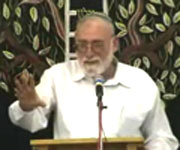Beit Midrash
- Sections
- Chemdat Yamim
- Parashat Hashavua
- Torah Portion and Tanach
- Shmot
- Terumah
The commandment to erect a mizbeach (altar) is found at the end of the parasha, after the command to make the Mishkan’s other vessels, its structure, its roof, and even its courtyard. Abarbanel was sensitive to this point and also raises the issue that the Torah says to build hamizbeiach (the altar), as opposed to the other vessels, which are written without the use of an article (e.g., an ark). He explains that "the" indicates that everyone was awaiting mention of the mizbeiach, since to people of that time, the main element of service of a deity was the bringing of sacrifices. This includes Adam and Noach, and also our great early leaders, such as the patriarchs and Moshe at the time of the giving of the Torah. So it is as if there is a known mizbeiach to which the word "the" refers to. Despite this, the Torah waits until close to the end to describe it.
David and Shlomo also saw the importance of the order, as we will explain. Both brought many korbanot when taking steps towards or actualizing, respectively, the building of the Beit Hamikdash. David did so when he uncovered the place where the Beit Hamikdash would stand (Shmuel II, 24:24-25), as stressed in Divrei Hayamim (I, 22:1), and when bringing the aron to Yerushalayim (Shmuel II, 6:12-13). Shlomo is described as bringing korbanot that were so many that they could not be counted (Melachim I, 8:4-5). Yet regarding building the Beit Hamikdash, it was not the mizbeiach that was stressed but the matter of the aron, especially in the way it was brought to Yerushalayim and brought to its permanent place (Melachim I, 6). Only in Divrei Hayamim does the building of the mizbeiach receive serious treatment, including regarding the descent of fire to the mizbeiach. In the writings of Chazal, as well, it is the moment of the bringing of the aron into the Mikdash that is described in exciting detail.
Our preoccupation with the aron, as opposed to the mizbeiach, also explains the halacha that when the aron leaves the area of the Mikdash, the Mikdash loses its status as the only place to bring a korban (Yerushalmi, Megilla 1:12). All of the above sends the following message. The dwelling of the Divine Presence, which is represented by the aron¸ is the main purpose of the sanctuary, not the ability to bring sacrifices. Let us pray for the restoration of the Mikdash and the fulfillment of the pasuk: "They will make for Me a sanctuary, and I will dwell in their midst" (Shemot 25:8).

Parashat Hashavua: A Rare Commodity – The Right Blend of Unity and Humility
Rabbi Yossef Carmel | Tevet 5786

Shema Yisrael – One G-d, Three Contexts
Rabbi Yossef Carmel | Elul 15 5776

To the Desert Once Again
Rabbi Yossef Carmel | Iyar 5768






















